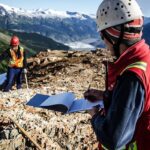
Comprehensive Exploration of AVO-Friendly Processing
AVO-friendly processing, known interchangeably as ‘true amplitude,’ ‘amplitude-friendly,’ and ‘controlled amplitude, controlled phase’ (CACP), often becomes a muddled area for geophysicists. The exact interpretation of what constitutes AVO-friendly processing is a contentious topic within seismic geophysics, leading many to believe it remains a well-kept secret within the profession.
In understanding the concept of AVO, or Amplitude versus Offset, it is essential to delve into the article discussing the harmonic mean equation, which provides valuable insights into seismic data analysis techniques.
Instances That Require Extra Diligence
The vagueness surrounding AVO-friendly processing doesn’t undermine the criticality of certain processes that could adversely affect your AVO analysis. Here are some instances that call for an extra level of care and discernment:
- Any process that isn’t surface consistent. Oliver Kuhn, now with Quantec in Toronto, describes a surface-consistent process as one where a shot-related process affects all traces within a shot gather uniformly, independent of their receiver positions. Similarly, a receiver-related process affects all traces within a receiver gather in the same way, regardless of their shot positions;
- Any process involving a window, be it spatial or temporal, requires caution. Make windows larger or longer than your areas and zones of interest to preserve relative effects;
- Any process compromising data accuracy for the sake of flattening gathers. Not all flat gathers will appear flat;
- Avoid last-ditch attempts to improve the data, or ‘cosmetic’ treatments, such as wavelet stretch correction and spectral shaping. These treatments may benefit structural interpreters, but are unsuitable for seismic analysts. It is best to obtain volumes without these treatments and verify they caused no harm;
- Guard against unfounded assurances, such as “This should be fine!” without any evidentiary backing.
Spectral Shaping & Wavelet Correction

Spectral shaping and wavelet stretch correction have sparked considerable debate. On a superficial level, these processes may seem easy to model. However, the complexity arises when you delve into ‘wavelet perception’ and wavelet definition. Moreover, the question of ‘seismic reflection functionality’ can further complicate the matter. As we get more adept at examining spectral decompositions of stacked and pre-stack data, a sense of skepticism continues to linger.
The Dilemma of Divergent Processing Paths
In long-term projects, seismic data can often be manipulated through two distinct processing paths for structural interpretation and AVO analysis. Such practice can introduce significant error due to the inability to accurately integrate quantitative results into the structural framework.
Critical Approach to Processing Algorithms
A scientific approach to processing algorithms, much like a clinical trial, is a suggested solution. Testing these algorithms against a known model like Marmousi and documenting their influence on attributes could yield beneficial results. If such studies exist—or would be of interest—for a potential discussion or even a hackathon, it would certainly pave the way for better understanding.
Necessity of Consistent Data Processing

The precise and consistent processing of data is essential for accurate results. Regardless of the processing path—structural interpretation or AVO analysis, maintaining consistency is of utmost importance. Any discrepancy in data processing can lead to significant errors in interpretation and final results.
While understanding AVO-friendly processing can be puzzling, it is vital for professionals working in seismic geophysics. With adequate awareness and application of proper methodologies, one can perform accurate and efficient analyses.
Conclusion
Understanding AVO-friendly processing’s intricacies remains an elusive concept, leading many to view it as seismic geophysics’ clandestine aspect. However, with vigilant attention to specific processes, the avoidance of detrimental practices, and a discerning approach toward spectral shaping and wavelet stretch correction, one can navigate these complex waters. The necessity of appropriate algorithm testing and the pursuit of consistent data processing underline the importance of precision in this field. In conclusion, while AVO-friendly processing may pose challenges, a pragmatic approach and persistent learning can pave the way for successful seismic analysis.
In essence, navigating the complexities of AVO-friendly processing can be a daunting task. However, with thorough understanding, careful application, and a healthy dose of skepticism, it’s entirely manageable. By ensuring surface consistency, exercising caution with windows, prioritizing data accuracy over gather flattening, and abstaining from unwarranted ‘cosmetic’ treatments, seismic analysts can preserve the integrity of their work. A commitment to scientific rigor and consistency should guide all explorations in seismic data processing. While debates persist over the functionality of spectral shaping and wavelet stretch correction, continual learning and open discussions can pave the way for clarity and progress. It’s crucial to remember that divergent processing paths can lead to significant errors in the structural framework, stressing the importance of consistent data handling. Consequently, a thorough understanding of AVO-friendly processing is not just a benefit, but a necessity for anyone involved in seismic geophysics.

















